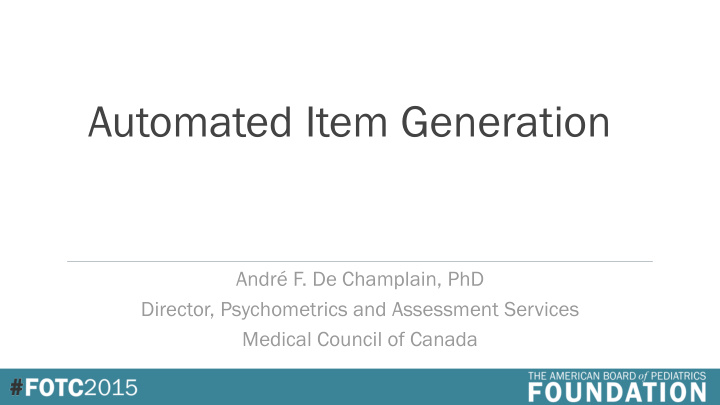



Automated Item Generation André F. De Champlain, PhD Director, Psychometrics and Assessment Services Medical Council of Canada
What is Automated Item Generation (AIG)? • Aut utomat ated ed it item em gener generat atio ion (A n (AIG IG) ) is is the p e proces ess o of us using it ing item em model els to gener enerat ate e tes est it item ems w wit ith the aid e aid of c computer t tec echno nology • AIG uses a 3-stage process for generating items where the cognitive mechanism required to solve the items is identified and manipulated to create new items
The Item Writing World As We Currently Know It..
The Item Writing World As We May Come to Know It….
The Item Writing World As We May Come to Know It…
AIG Methodology • The m e model el i includes des three k ee key outcomes: es: 1. 1. Id Ident entif ify T THE PR PROBLEM (i.e., Post-Operative Fever) 2. 2. Specify y sou sources of i information required to diagnose the problem (i.e., Type of Surgery, Physical Examination, etc.) 3. 3. Des escrib ibe KE e KEY feat eatur ures es within each information source (e.g., Guarding and Rebound, Fever, Calf Tenderness, etc.) needed to create different instances of the problem
AIG Methodology • Item models are created using the cognitive model content, where an item model is like a template, a rendering, or a mold of the assessment task (i.e., it’s a target where we want to place the content for the item) • A 54-year-old woman has a <Typ ype of S of Surg rgery>. On post- operative day <Timin ming of F of Fever>. The patient has a temperature of 38.5c. Physical examination reveal <Physic ical al Examin xaminat atio ion>. Which one of the following is the best next step? • Typ ype of of Surg rgery: Gastrectomy, Right Hemicolectomy, Left Hemicolectomy, Appendectomy, Laparoscopic Cholecystectomy • Ti Timing of of Fever: 1 to 6 days • Physic sical al E Examin xaminat atio ion: Red and Tender Wound, Guarding and Rebound, Abdominal Tenderness, Calf Tenderness
AIG Methodology • After the item model is specified, we combine this information systematically to produce new items • To accomplish this complex combinatoric task, we created software for item generation called IGOR (Item GeneratOR) • IGOR was programmed using Sun Microsystems JAVA
What Have We Learned? • The MCC has been working on AIG with the University of Alberta (Mark Gierl and Holli Lai) for the past 5+ years • Tens of thousands of items have been generated across 50+ cognitive maps • Predictive identification accuracy ranged from 32% to 52% across four experts, with an average accuracy rate of 42% • Expe perts s cannot s systematically lly differe rentiate AIG f from t m trad adit itio ional al i items ms • Piloted AIG items cover shallow areas of our pool very well • On average, AIG items are more difficult and discriminating (based on classical and IRT statistics) • Directly attributable to the AIG process
Next Steps for the MCC • Undertake 2 additional AIG content development workshops in May and September, 2015 • ~ 20 new cognitive maps • Pretest 80-100 AIG items in the spring, 2015 MCCQE Part I exam cycle • Selected from 2014 cognitive maps and generated items • Create several apps that will further automate the AIG process and allow us to fully transition AIG to the MCC • Complete a cost-benefit analysis of AIG vs. traditionally written items
Recommend
More recommend